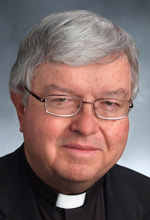Q. It has been 30 years since I last saw this happen, but at Sunday Mass yesterday a couple and their two children got up from a pew in front of me just as Communion was about to be distributed and walked around our section of pews in order to get in line to receive from the priest instead of from a lay eucharistic minister. I am fighting being judgmental, but I can’t believe that this still happens. How might a priest deal with this? How might those who witness it best react? (St. Paul, Minnesota)
A. It is, of course, the same Eucharist — whether received from a priest or from a lay minister — and like you, I am a bit surprised when someone feels compelled to make a choice. You may have not seen it for 30 years, but my experience is more current. Up until a few weeks ago, there was a man in our parish who consistently refused to take the consecrated host from a layperson. (I say until a few weeks ago because the man has since passed away.)
When the distribution of Communion began, he would remain in the back of the church. At the end, when I would go up to give Communion to those unable to negotiate the aisle (our floor is sloped downward toward the altar), he would walk over to me, fall to his knees and take the host in his mouth.
[hotblock]
I respected his choice and never made an effort to change his behavior. In the scope of things, I felt that his preference was a small issue. For me, it came under the heading of the “big tent” that embraces a wide variety of Catholics. (For safety reasons, I did, some years ago, speak to him about his habit of walking down the Communion aisle and suddenly dropping to his knees when he reached the priest, leaving the people behind him hard-pressed not to fall in a pile on top of him!)
Q. I raised my children to respect all people, to understand differences in nationalities, races and family traits and to know that God created everyone. But this week’s issue of our Catholic newspaper raises a serious question for me. I opened it to find two pages dedicated to a joint conference of national black sisters, national black clergy, national black deacons and national black seminarians.
My question is this: If the conference had referred to national white sisters, white clergy, white deacons, etc., don’t you think it would have incited a frenzy? Please help me to understand how one is acceptable to the church and society while the other is not. (Charleston, South Carolina)
A. Black clergy and religious — rather logically, I would think — have combined their efforts to deal with issues of special concern to black people in the church and in society. This coordination first began in 1968 during the civil rights movement when our nation was beginning to give greater attention to the sin of racism.
The primary focus currently seems to be evangelization — how to give the Catholic Church greater relevance with African-Americans, in part through the joy and enthusiasm of liturgical celebration. Attention also is given to societal issues that impact black people in particular.
The 2015 joint conference of the National Black Sisters Conference, the National Association of Black Catholic Deacons, the National Black Catholic Seminarians Association and the National Black Catholic Clergy Caucus in Charleston, South Carolina, for example, called for the abolition of the death penalty and referenced studies that show race and poverty are often determining factors in our criminal justice system.
***
Questions may be sent to Father Kenneth Doyle at askfatherdoyle@gmail.com and 40 Hopewell St. Albany, N.Y. 12208.




Father Ken, in your comments above are you referring to Extraordianary Eucharistic Ministers, who are to distribute Holy Communion when ordinary ministers of Holy Communion are unavailable, am I correct?
What I am shocked about is how some EEM dress for their task. According to the Catechism of Catholic Church: “EMHCs must show utmost reverence for the Eucharist. This reverence is reflected in their demeanor at Mass (full, active and conscious participation in the liturgy; CSL 14), their attire, and the manner in which they handle the Eucharist.A neat and reverential appearance is in keeping with the minister’s role and belief in the presence of Christ in the Eucharist.” What shocks me is to see some EEM wearing mini skirts and tank tops in neon colors when performing this honorable task. That is shocking to me, not some older man who wished to honor the Lord in a way that has been practiced for centuries and still is in most of the world. (May he rest in peace.) Please Father address this issue if you find it worth talking about. Thank you kindly.
to the question from St. Paul. What he did is his right under Canon Law.
Perhaps you should concern yourself with your attitude.
Do you object to people who only receive on the tongue? If you do YOU would have a problem in many countries throughout the world. The reception on the tongue is the PERFERED method according to Canon Law and in many countries reception in the hand is FORBIDDEN!! STOP MAKING UNINFORMED JUDGEMENTS